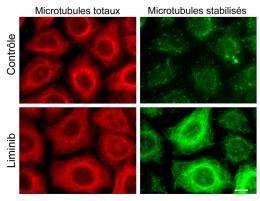Liminib stabilizes the microtubules. Microtubules are filamentous structures that can be visualized using specific antibodies. Thus, in a same cell, the total microtubules can be on labeled in red and the stabilized microtubules in green. Unlike the control cells, numerous green, stabilized microtubules can be observed in the Liminib treated cells. The scale bar (in white, bottom right hand photo) represents 10 µm. © Lafanechère/CNRS
A new molecule with anti-cancer and anti-metastatic properties has been discovered by teams from CNRS, CEA, the Institut Curie and Inserm, in collaboration with Australian and British researchers. This anticancer drug acts on cells resistant to conventional chemotherapy thanks to an entirely novel action mechanism. It targets not only the multiplication of cells but also their mobility and thus could prevent the formation of metastases. Published in Cancer Research, the results obtained in vitro and on animals could, in the medium term, lead to the development of alternative anti-cancer treatments.
The appearance of resistant tumors considerably limits the efficacy of conventional chemotherapy treatments. In addition, the dissemination of metastases is the most frequent cause of death of patients suffering from cancer. It is for this reason that the researchers explored various therapeutic approaches, particularly the development of novel drugs that are active on resistant cancers and which prevent the formation of metastases.
It took nearly ten years for a group of biologists and chemists from CNRS, CEA, the Institut Curie and Inserm, in collaboration with Australian and British scientists, to succeed in their quest of discovering and characterizing a new anti-cancer and anti-metastatic molecule. To do so, the researchers used a robotic high-throughput screening platform: nearly 30,000 molecules were tested until one from the chemical library of the Institut Curie exhibited the sought-after activity on tumorous cells and was thus selected. Known as Liminib (or Pyr1), this new molecule has been identified as an inhibitor of LIM Kinase (LIMK). Overexpressed in invasive carcinoma, LIMK represents a relevant therapeutic target that is generating considerable interest in numerous laboratories. This kinase is known to regulate the dynamic of the internal skeleton of the cell, constituted of a network of fibers, including filaments of actin and microtubules that allow the cells to move and multiply, two properties actively used by cancerous cells.
Liminib is thus the first LIMK inhibitor discovered that exhibits anti-cancer properties. This molecule blocks the mobility of the cells by disorganizing the cytoskeleton of actin and also brings about a stabilization of the microtubular network, thereby preventing the cells from multiplying, through a mechanism different to that of Taxol, a widely used anti-cancer drug. The researchers show that Liminib is toxic to several cancerous cell lines in vitro, including cell lines resistant to chemotherapy. In addition, the results of a "pilot" preclinical study conducted on a mouse model are encouraging: they reveal not only good efficacy but also good tolerance to the new molecule. In the medium term, this work could lead initially to the development of alternative treatments for patients for whom therapy is no longer an option.
More information: Pharmacological inhibition of LIM Kinase stabilizes microtubules and inhibits neoplastic growth. Prudent R, Vassal-Stermann E, Nguyen CH, Pillet C, Martinez A, Prunier C, Barette C, Soleilhac E, Filhol O, Beghin A, Valdameri G, Honore S, Aci-Seche S, Grierson D, Antonipillai J, Li R, Di Pietro A, Dumontet C, Braguer D, Florent JC, Knapp S, Bernard O, Lafanechère L. - Cancer Research (online since the 3 July 2012. The paper version is due to be published in September 2012)
Journal information: Cancer Research
Provided by CNRS



















